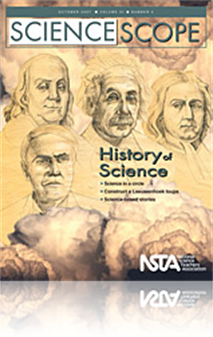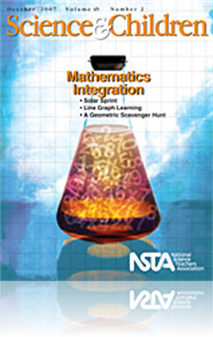All Resources
Journal Article
This cooperative activity presents middle school students with the opportunity to explore and discover, as well as enjoy their own communications with one another. By employing reading, writing, and history as an integrated approach to teaching abou...
Journal Article
Methods and Strategies: Science Success for Students With Special Needs
Recent special education legislation such as the Individuals with Disabilities Act (IDEA) emphasizes the placement of students with mild disabilities in the general education classroom. Therefore, students with learning, behavior, and communicating d...
Journal Article
The Prepared Practitioner: Constructivism and Conceptual Change, Part I
Constructivism is the basis for standards, inquiry-based instruction, and a candidate for buzzword of the decade. But what is constructivism? This month’s column provides the answer to this thought-provoking question, and explains why it can be a c...
Journal Article
The Early Years: Counting a Culture of Mealworms
Math is not the only topic that will be discussed when young children are asked to care for and count “mealworms,” a type of insect larvae (just as caterpillars are the babies of butterflies, these larvae are babies of beetles). The following act...
Journal Article
Current Taxonomy in Classroom Instruction
The ability to sequence genes has vastly altered our understanding of higher-level relationships among organisms such as those found at the kingdom level. It is important for biology teachers to incorporate these new views and not retain outdated con...
Journal Article
Career of the Month: An Interview with Space Architect Constance Adams
Drawing knowledge from many fields—including science, engineering, and art—space architects such as Constance Adams design structures for nonterrestrial environments. In one such project at NASA, Adams works on elements for the International Spac...
Journal Article
Teaching Science Using Stories: The Storyline Approach
Storytelling is an age-old and powerful means of communication that can be used as an effective teaching strategy in the science classroom. This article describes the authors’ experiences implementing the Storyline Approach, an inquiry-based teachi...
Journal Article
Many children enjoy collecting items such as seashells, state quarters, and trading cards. Asking students to think about the ways in which similar items differ, how objects can be grouped by a common characteristic, and how groups can be subsets of ...
Journal Article
Tried and True: Our class periodic table
To facilitate discussions centered on the topic of chemistry, students can create a classroom periodic table. In order to accomplish this task, they research elements in the periodic table using various media (textbooks, Internet), and then create a ...
Journal Article
Launch Excitement with Water Rockets
Explosions and fires—these are what many students are waiting for in science classes. And when they do occur, students pay attention. While we can’t entertain our students with continual mayhem, we can catch their attention and cater to their des...
Journal Article
Nematodes: Model Organisms in High School Biology
In a collaborative effort between university researchers and high school science teachers, an inquiry-based laboratory module was designed using two species of insecticidal nematodes to help students apply scientific inquiry and elements of thoughtfu...
Journal Article
How Much Popcorn Will Our Classroom Hold?
How much popcorn will our classroom hold? This intriguing question sparked a terrific integrated science and math exploration that the author conducted with fifth-and sixth-grade students....
Journal Article
Extrasensory Perception—Pseudoscience?
This case teaches students to be skeptical of “scientific claims,” especially those that are sensational and fall outside the boundaries of normal scientific explanation. Students read the case scenario and then evaluate data to determine whether...
Journal Article
Science Sampler: A first energy grant—Pinwheel electrical generation
This is an interdisciplinary activity—with art, science, and math classes involved—where students design their own pinwheels, and then attach their design to a DC generator (motor). Prior to testing their designs, students are introduced to bas...
Journal Article
The Radish Party inquiry is designed to teach the importance and relevance of soil organic matter to young students. In this investigation, students grow radishes in three different kinds of soils: sand, sand plus nutrients, and potting soil (soil th...






